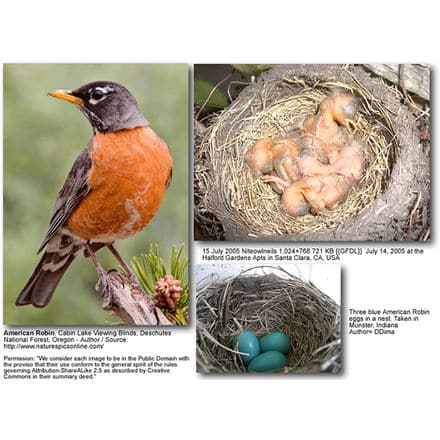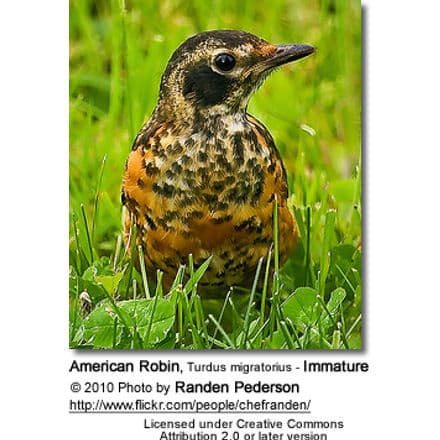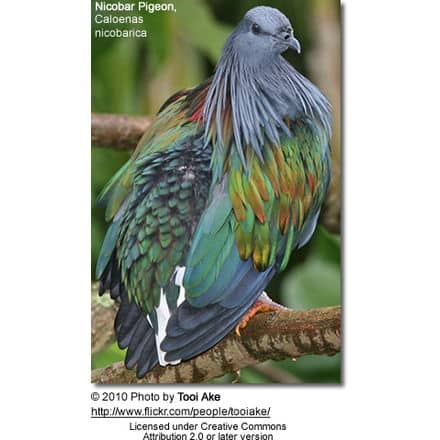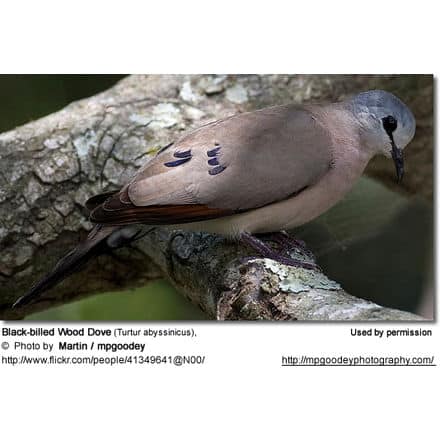American Robin
The American Robin or North American Robin (Turdus migratorius) is a migratory songbird that was named after the European Robin due to the male’s bright red breast, though the two species are not closely related.
The American Robin has a wide distribution throughout North America. They winter south of Canada from Florida to central Mexico and along the Pacific Coast.
This Robin has been named the State Bird of Connecticut, Michigan, and Wisconsin.
The longest known lifespan of an American Robin is 14 years. However, the average lifespan is about 2 years. Bird banders found that only 25% of young Robins survive the first year.
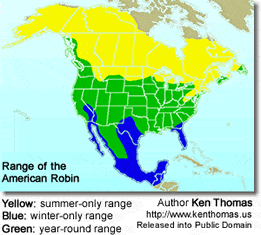
Description:
The nominate subspecies of the American Robin is 23–28 centimeters (10–11 in) long with a wingspan ranging from 31–41 centimeters (12.2–16 in), and averages about 77 grams (2.7 oz) in weight.
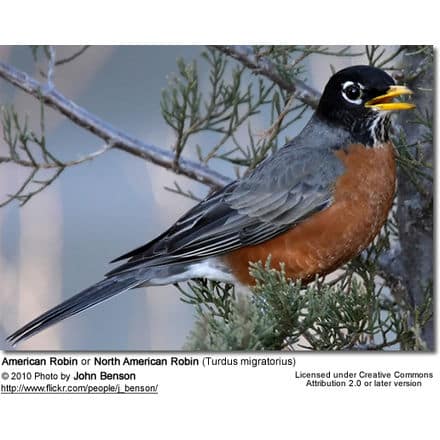
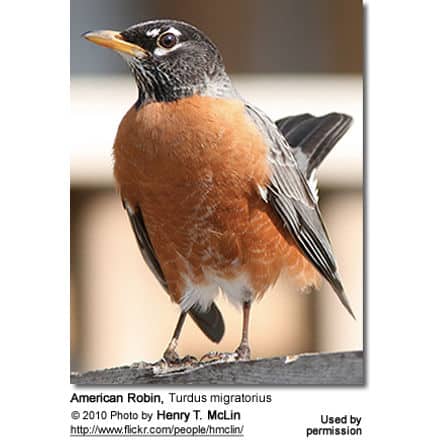
The head varies from jet black to grey, with white eye arcs and white supercilia (“eye brow”). The throat is white with black streaks, and the belly and undertail (feather) coverts are white. The Robin has a brown back and a reddish-orange breast, varying from a rich red maroon to peachy orange. The bill is mainly yellow with a variably dark tip, the dusky area becoming more extensive in winter, and the legs and feet are brown.
Males and females look similar, but the female tends to be duller than the male, with a brown tint to the head, brown upperparts and less bright underparts. However, some birds cannot be safely sexed on plumage alone.
The immature birds are paler than the adult male and have dark spots on the breast, as well as whitish wing coverts (feathers).
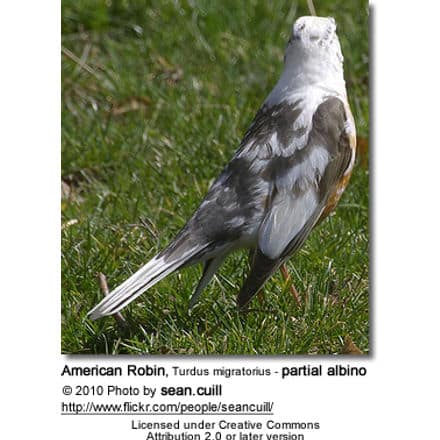
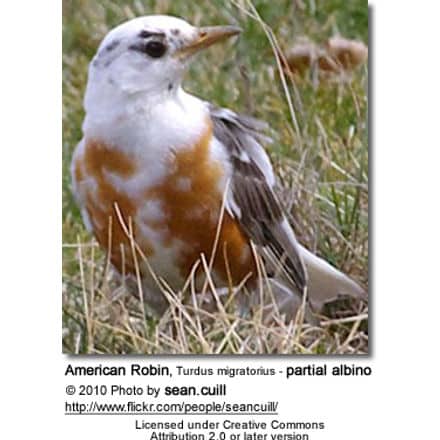

Subspecies. Ranges and ID
- T. m. migratorius (nominate subspecies)
- Breeds: US and Canada, other than down the west coast, to the edge of the tundra from Alaska and northern Canada east to New England and then south to Maryland, North Carolina and northwest Virginia.Winters: southern coastal Alaska, southern Canada, most of the US, Bermuda, the Bahamas and eastern Mexico.
- T. m. nigrideus
- Breeds: Coastal northern Quebec to Labrador and NewfoundlandWinters: Southern Newfoundland south through most of the eastern US states to southern Louisiana, southern Mississippi and northern Georgia.
- ID: Darker or blackish on the head, with a dark grey back. Underparts are slightly more red than those of the nominate subspecies.
- T. m. achrusterus
- Breeds: Southern Oklahoma east to Maryland and western Virginia and south to northern Florida and the Gulf states.Winters: Southern part of the breeding range
- ID: Smaller than the nominate subspecies. The black feathers on its head have pale grey tips. Underparts are paler than those of the nominate subspecies.
- T. m. caurinus
- Breeds: Southeast Alaska through coastal British Columbia to Washington and northwest OregonWinters: Suthwest British Columbia south to central and southern California and east to northern Idaho.
- ID: Slightly smaller than nominate subspecies. Very dark-headed.
T. m. propinquus- Breeds: Southeast British Columbia, southern Alberta, southwest Saskatchewan south to southern California and northern Baja CaliforniaWinters: Southern breeding range down to Baja California.
- ID: Either the same size or a little larger than nominate form. Plumage paler and tinged more heavily brownish-grey.
- T. m. phillipsi
- Range: Mexico south to central Oaxaca – resident.
- ID: Slightly smaller than propinquus described above – but has a larger beak. Underparts of the male is less brick-red and have a rustier tone than that of the nominate species..
- T. m. confinis
- breeds above 1000 meters (3300 ft) in the highlands of southern Baja California.
- ID: Relatively small. Pale grey-brown underparts – the palest subspecies. Head, face and upperparts are a uniorm pale gray-brown. Sometimes classified as a separate species, the San Lucas Robin.
Distribution
They throughout most of North America, from Alaska and Canada southward to northern Florida and Mexico.
They occasionally overwinter in the northern part of the United States and southern Canada. However, most migrate to winter south of Canada from Florida and the Gulf Coast to central Mexico, as well as along the Pacific Coast. They depart south by the end of August and begin to return north in February and March.
They are rare vagrants to western Europe, Greenland, Jamaica, Hispaniola, Puerto Rico and Belize.
They inhabit woodland and more open farmland and urban areas. They rarely breed in the southern US. They prefer large shade trees on lawns.
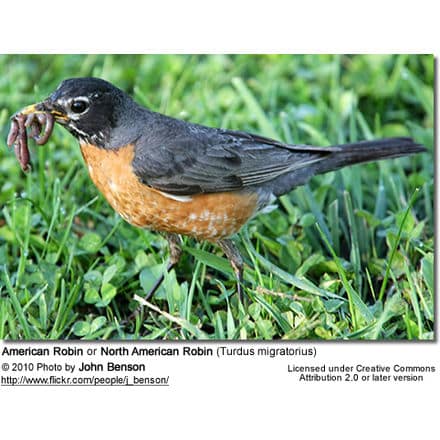
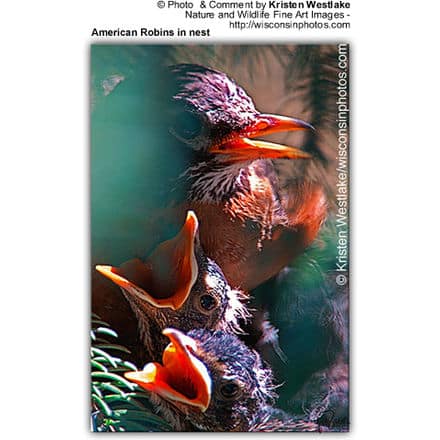
Diet
They active mostly during the day and assembles in large flocks at night. Its diet consists of invertebrates (such as beetle grubs and caterpillars), fruits and berries.
It is one of the first bird species to lay eggs, beginning to breed shortly after returning to its summer range from its winter range. Its nest consists of long coarse grass, twigs, paper, and feathers, and is smeared with mud and often cushioned with grass or other soft materials. It is among the first birds to sing at dawn, and its song consists of several discrete units that are repeated.
Breeding
The American Robin begins to breed shortly after returning to its summer range. It is one of the first North American bird species to lay eggs, and normally has two to three broods per breeding season, which lasts from April to July.
The nest is most commonly located 1.5–4.5 meters (5–15 ft) above the ground in a dense bush or in a fork between two tree branches, and is built by the female alone.
The outer foundation consists of long coarse grass, twigs, paper, and feathers. This is lined with smeared mud and cushioned with fine grass or other soft materials.
A new nest is built for each brood, and in northern areas the first clutch is usually placed in an evergreen tree or shrub while later broods are placed in deciduous trees.
The American Robin does not shy away from nesting close to human habitation.
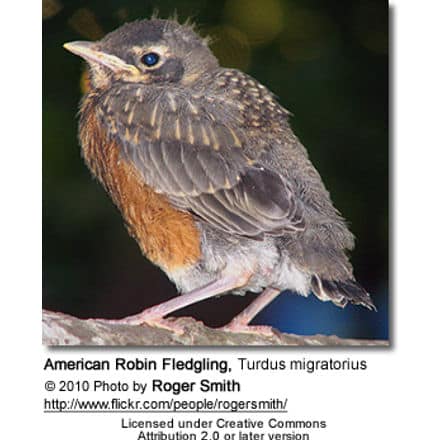
A clutch consists of three to five light blue eggs. The eggs are incubated by the female alone.
The young hatch after 14 days and the chicks are born naked and blind, and are completely dependend on their parents for warmth, feedings and protection. They develop fast, however, and are able to leave the nest about 2 weeks after hatching.
The adult male and female both are active in caring for the fledged chicks until they learn to forage on their own. The young are able to fly short distances after leaving the nest.
Vocalization
The male American Robin’s song is described as a cheerily carol. It’s alarm call sounds like: PEEK!! tut tut tut tut… often preceded by an explosive seeech each-each-each.
Robins make alarm calls and dive-bomb potential or real predators.
